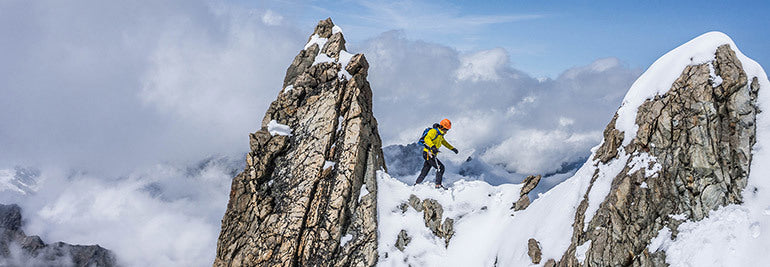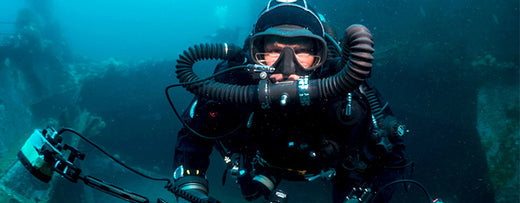

Suunto Blog

This is how Kilian Jornet prepares for Everest
This summer Kilian Jornet takes on the challenge of climbing Mount Everest, the final peak in his Summits of My Life project. Kilian will try to establish a record for the ascent and descent by a little-used route on the north face of the world’s highest mountain. To be ready for the challenge, he has spent a lot of time high in the Alps. Here are two of his training days on the Mont Blanc massif.
Physical training in the Alps: 6500 meters of climbing. (10.7.)
Kilian Jornet is taking on Everest with the purist and minimalist philosophy that is the trademark of the Alpine style. This means that, as with other challenges in the Summits of My Life project, he intends to complete the ascent in one go, without stopping at high-altitude camps. This is different from the classical Alpine approach but he has also acclimatizing himself in a different way. Kilian Jornet and his team intend to spend the last few weeks before they go to the Himalayas at a high altitude in the Alps.
Kilian’s training day high up on Mont Blanc Massif with over 3500 meters of climbing. (25.7.)
"It’s a new approach to acclimatization. Before we set off for the Himalayas we will have partly acclimatized having spent some days at altitude. This means we won’t have to wait so long to start when we arrive at the Everest base camp,” explains Jordi Tosas, Kilian’s teammate on Everest.
"This means we’ll be stronger when we begin the ascent. It can make you weaker if you spend several days acclimatizing yourself on the mountain. With this type of acclimatization we can begin the challenge with more energy and a better chance of success,” Kilian adds.
Main image: © Lymbus
Create Suunto Movies of your adventures with Suunto App.

5 invaluable staged trail race training tips
“Commit to the training before you commit to the race” – Trail runner, Rene Unser.
Image: Carrie Karsgaard (Feature image: Nathan Karsgaard)
Canadian Rene Unser, who will race the Gore-Tex Trans Alpine Run for the sixth time this year, is a trained coach with 13 years experience. She has also put together the official training plans for the epic Alpine race. So if anyone can give some helpful training tips it’s Rene, here’s what she had to say:
Commit to training
“Commit to the training before you commit to the race,” says Rene. She knows how big a time commitment a long distance race can be. A training schedule is also key, she adds: “To be successful it’s important to build up slowly, and train consistently. Find a training schedule that works for you and really dial that down.”
Mimic the race terrain
Do you know whether you’ll be running on hills or flat? Find out says Rene: “Mimic the terrain you will find during the race as much as you can! This can be hard for people who don’t live near the mountains, but it’s worth travelling to get there when you can."
Image: Schneider outdoor vision
Test your equipment
“Test your equipment and spend time running with your bag packed as it would be during different stages,” says Rene. All races are different, with some equipment being mandatory, she adds: “Learn how to use poles efficiently if they are permitted in your race, and if you choose to use them.”
Get your nutrition spot on
Of course fuelling before and after a race can make a huge difference, and Rene works with what she’s given in any particular race. She says: “I train with Hammer Nutrition Perpetuem with water and Hammer Gels. Before a race I start to practice with the food I’ll get at the aid stations. For TAR this is salami, cheese and cake. I am able to supplement with what’s provided if I have my staples. I aim for 120 to 150 calories an hour during a race.”
Take it easy
“A lot of people will cram a lot of races into a season, and it’s natural to want to do this,” says Rene. But try not to, she adds: “They want to squeeze in a 50k race as that’s what one stage in the race might be like. I caution all my athletes training for races like TAR not to have too many late season races, as it uses up valuable training time, by the time you factor in your taper and recovery.
Follow Rene on her website, Facebook, instragram and personal website.

Megan Cook takes over @suuntodive Instagram
Underwater explorer Megan Cook is taking over the @suuntodive instagram for a week, starting today, August 1, 2016. Join her as she retraces the first US ocean exploration expedition.
Who are you and where are you from?
My name is Megan Cook and I am an underwater explorer! I work for a deep ocean exploration and education group called Ocean Exploration Trust and am proud to have fed my insatiable ocean curiosity as a reef fish researcher, marine debris mitigator, freediving instructor, science communicator, and Rolex Scholar. I currently live in Newport, Rhode Island but am inviting you, the SuuntoDive family and fans, along on an adventure with me in Washington State’s Salish Sea on the US west coast.
I’m joining my friends to #retracethewake of the United States’ first ocean exploring expedition which travelled the world from 1838-1842. In 1841, the six ships of the US Exploring Expedition rowed and sailed their way around Puget Sound, British Columbia’s Salish Sea and the San Juan Islands pioneering the discipline of oceanography and gathering a rich scientific record to the region. The trouble is…they weren’t divers. We know now they were rowing over the top of some of the richest marine habitats and most productive ecosystems on the ocean planet. Come with me as I sail along the path of these 19th-century explorers diving at their study sites and introducing you to the fascinating life they missed underneath the waves.
Where do you dive?
I dive wherever I have the chance. I was originally certified in southern Idaho- my home state - hundreds of miles from the nearest ocean. I saw seven tires and one fish in that desert reservoir. Since that time I’ve been thrilled to dive in many beautiful pieces of water from Switzerland to South Africa, Australia to Antarctica!
What inspires you in the underwater world?
I am inspired by the vastness still waiting to be discovered in our oceans! Over 90% of the ocean remains unexplored. We have barely started reading the owner’s manual for the most important life support system on our planet. I love introducing new people to the ways the ocean touches their life, even if they have never touched the waves. I learn something new every time I put my face in the water and that wonder will never cease.
Is there a story that you wish to tell with your images?
Rather than highlight my greatest shots, I’m bringing followers live on an adventure as it unfolds. Together the crew share three decades of dive experience, but diving from the S/V Whistledown, a 35 foot, Spencer sloop will be a brand new adventure for everyone involved in this project.
This trip has helped me remember that for every brand new possibility on a mile of ocean, there is also a rich history. Many of the creatures we’ll meet during this photography trip will be well-known aquatic neighbours, yet the possibility of discovering new views, and fresh perspective is constant. Moving at sailing speed, I’m looking forward to glimpsing views of the inland ocean that astounded the sailors over 170 years ago. Come along with us using #retracethewake or by following me at @missmegancook. #RetraceTheWake will continue for five weeks sailing around Puget Sound and the San Juan Islands.
How to follow along.
You can follow Megan’s ocean adventures on Facebook, Twitter and Instagram. The sailing expedition runs from late July - late August 2016 and will be posting using #retracethewake.

Jill Heinerth becomes the first RCGS Explorer in Residence
Suunto ambassador Jill Heinerth has been named the first Explorer in Residence of the Royal Canadian Geographical Society, we’ve spoken to her to find out what’s involved in this new role.
Jill speaking about her new role in Ripley's Aquarium in Toronto (Header image: ©Cas Dobbin 2016)
Canadian cave diver Jill is well known for exploring little known places across the globe, and this makes her the perfect person to take up this new role. Read what she has to say about what she’ll be doing as Explorer in Residence.
So, what does becoming Canada’s first Explorer in Residence mean for you?
This appointment is a bit of a "girl's dream come true" story. The dream of a little girl who was told that nothing was impossible. The dream of a young Girl Guide who was taught how to live in balance with her world. The dream of a woman who discovered that doing what you love nets far greater gains than can be measured by a paycheck. It is certainly validation for a lifetime of hard work as well as an opportunity to reach out to more people with a message about exploration, discovery and conservation of our natural world.
It must feel pretty great, right?
I am incredibly honored to be recognised in my home country and given the vote of confidence that I can carry a great message, especially to young people pursuing new and interesting careers.
Deck gun on the SS Lord Strathcona, Bell Island Newfoundland. Photo: Jill Heinerth, IntoThePlanet.com
How did you end up being given this new role?
In 2013, I was awarded the first ever gold medal for exploration given in Canada; The Sir Christopher Ondaatje Medal for Exploration, awarded by the Royal Canadian Geographical Society, but this appointment was a complete surprise. I literally received a phone call while standing by the edge of spring in my drysuit. "Would I accept the appointment and help the society define the program for the future?" Needless to say, my waiting students were pretty surprised to see me jumping around in excitement on the cell phone in the middle of the woods.
What does the role involve?
I have two key goals. First, I want to reach deep into the educational system to inspire young people to explore…. both in person and through modern online outreach opportunities. I want today’s youth to understand that the world is at their fingertips through a connected global community. I want young people to recognise that they can make bold moves creating new careers and initiatives to solve emerging problems that are important to them. I want them to know that anything is made possible through diligence and teamwork.
Secondly, I want to share my adventures to help nurture a better connection between Canadians and their water resources. I want us all to celebrate and protect the summer arrival of humpback whales feeding on swarms of capelin in Newfoundland. I want to inspire parents to take their kids to Lake Winnipeg to play, so they will want to keep safe the vast watershed it serves. I want our citizens to learn from our First Nations fore-bearers about how to live in better harmony with our natural resources. I want to help my fellow Canadians understand that everything we do to the surface of our land will be returned to us to drink. I want to us to fully embrace how water flows into and out of our lives.
As a female explorer, do you think it’s important to inspire women and girls to get outside?
As someone who was often searching for female role models in life, I realise that is a really important part of this appointment. I try to answer every email and take time with everyone that has a question. I recognise that even a single interaction and affirmation for a young woman can change her life and if I can help even one person find their direction, then that will be worth all the hard work!
For women, or girls, nervous about getting into the water, or even out exploring on land, what would you tell them?
I would like everyone to know that when we push the bounds of comfort, we will have great revelations in life. Being scared means that you still maintain a certain respect for your safety. That is important. But doing something a little outside your comfort zone will help you break barriers that might have contained your potential.
Jill meeting with kids on Bell Island Newfoundland
What will be your first adventure under your new title?
I am currently working with the society on their Expedition of the Year uncovering the Hidden Geography of Bell Island, Newfoundland. I am documenting the shipwrecks and exploring the mine in order to create a visual archive that will be granted to the Bell Island Historical Society so that they can improve education and tourism outreach initiatives.
What projects have you got planned for the coming months?
In the coming months, I will be shooting two National geographic projects in Mexico and the Bahamas. The first involves 3D capture of archaeological finds and the second involves documenting caves for a National Geographic TV special about the strange geological finds in underwater caves.

How deep can we go?
As freediver William Trubridge embarks on his attempt to dive to 102m unassisted in a single breath, he speaks to us about the future of the sport and how deep human beings could go.
Image (and feature image) Alex St Jean
Freedivers are continually pushing their boundaries, reaching depths never thought possible. William, as ever is leading the way and will attempt to break his current world record of 101m for the CNF discipline (Constant Weight No Fins) when he dives in Dean’s Blue Hole in the Bahamas on July 21,2016 as part of the Return To The Deep event produced by Steinlager Pure.
But what are the limits, will the point come when freedivers just can’t go any deeper? William suspects the answer is yes, but it’s not so clear-cut. He says: “I think we’re starting to plateau now. I wouldn’t like to speak too soon, but based on how I feel in my training, and what I’ve seen of results and performances over the last 15 years I’ve been involved in the sport, the rate of increase has definitely slowed down dramatically in the last five to eight years.”
"I think we're starting to plateu now."
Image Daan Verhoeven
The records have moved quickly as the sport progressed, from 81m at William’s first record, to 101m at his current standing. The chance of leaps like that being repeated could be slim he says: “I’ve added 20m and I don’t think, I can say pretty much for certain, that I’m not going to add another 20m on to that myself in that discipline and I would be really surprised if even in my lifetime we get to that kind of depth.”
Fellow freedivers are also less inclined to make predictions that they will reach greater depths, suggesting the industry feels a “natural limit” is nearing. That’s not to say more records won’t be reached, just not with the same frequency as previous years. William says: “I don’t think anyone would disagree that we can add a few meters on all of the disciplines. The prospect of much greater depths has dried up to a large extent. It’s hard to imagine an innovation that could change things.”
The motivation for William hasn’t abated, however, he still feels the drive to push himself further. “I definitely motivate myself and I feel like I have the same motivation now as I did 10 years ago,” he says. “I feel like it’s a sport where we peak a lot later in our lives than in other sports. It’s more comparable to marathon running or other endurance sports because it requires a lower metabolism, as well as a maturity and patience that comes with age,” he adds.
"I definitely motivate myself and I feel like I have the same motivation now as I did 10 years ago."
Image Daan Verhoeven
All this means the sport is changing; it’s not the same steady pprogression that existed when William was first breaking records. It’s allowing younger competitors to progress quickly, William says: “Once someone does a 100m constant weight dive, shortly after that you will have five people doing it. Paving the way is happening a lot in freediving and it’s enabled a lot of younger competitors to improve a lot more quickly than when we were getting into the sport. Less feeling around and more concrete methodology.”
There are some dangers with that too though, and William is keen for newer freedivers to remember it takes time to dive to greater depths. He says: “It means divers are getting to significant depths quite quickly and maybe they’re able to do the depth in terms of breath hold, but their lungs and thorax aren’t sufficiently adapted to accommodate the pressure so we’re running into more problems with injuries.”
Increasing depth gradually is key here, he says: “We always put the emphasis on the process and having a methodical and conservative approach to increasing depth. Better to take your time, building up confidence and adaptation to pressure slowly. “
Follow the record attempt live with Steinlager. Find out more about Willaim Trubridge on his website.

William Trubridge talks record attempts and the art of freediving
Events like Vertical Blue and the upcoming Return to the Deep promote freediving to the masses. But what contribution have they made to the sport? Record-breaking freediver William Trubridge tells us, read what he has to say here.
Image (and feature image) Alex St Jean
William Trubridge has been preparing to break yet another world record, he plans to dive to 102m unassisted in a single breath on July 21, 2016. He’ll do this in Dean’s Blue Hole, Bahamas as part of the Return To The Deep event produced by Steinlager Pure.
He’s been training hard for the event, and is feeling strong having recovered from a bout of illness. He says: “Training has been going really well recently. I’m in good shape. I got dysentery while trekking in Nepal and it’s taken time to get my health back. This year I’ve had a couple of niggles but nothing serious.”
He’s already broken records two years in a row at Suunto Vertical Blue and is clearly ready for this next attempt. These big events, William believes, have really contributed to the progress and development of the sport over the years.
Big events lead to revolutions in safety techniques
Image Daan Verhoeven
He says: “At Vertical Blue there was a lot of innovation we begun that went outside and elsewhere afterwards. Most importantly safety techniques were really revolutionised to make sure everyone in the team is trained to the highest level possible. That has set a standard that is now used in other events and at AIDA.”
These safety developments and innovations are key to ensuring athletes are able to push their boundaries and reach deeper and deeper depths. It’s particularly important when breaking records as it can have a big physical and mental impact on the body.
William has mentioned previously that when diving he leaves a part of himself behind. He says: “In a freedive there’s a subtraction of the stimuli around you, there’s no sound, very little light, no sensations of points of contact and that allows you to slow the mind through the absence of stimuli, pressure and the narcotic effects of gasses and high pressure add to that.”
Freediving is more than record attempts, it frees the mind
Image Daan Verhoeven
This meditative state is one of the attractions of freediving. “It almost feels like we’re cheating when we freedive because we can get into a meditative flow so quickly,” says William. That’s one of the beauties and attractions of it. Leave the rational, reasoning mind, for sure.”
This simple state, using your body, mind and not much else is also one of the reasons freediving is becoming more popular. William says: “There’s definitely a movement that is putting us in more intimate contact with nature and making us able to relate to it more clearly and deeply. Which is important in this age when nature is in such dire straits. I kind of feel that every freediver I teach, or everyone who is brought into the sport becomes a steward of the ocean.”
If it sounds like an all-encompassing sport, it really is, especially when record attempts are coming up. William has been dreaming about the attempt, he says: “Most of the dreams are related to the record attempts, competition or stress around the expectation and the whole event! They’re not related to the sensation of being underwater because I experience that so much I guess.”
Follow the event live with Steinlager. Learn more about William Trubridge on his website.










































































